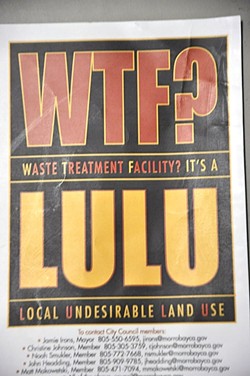A recent upswell of opposition to a location being considered for Morro Bay’s water reclamation facility has city officials on the hot seat as they mull over their options.
The city’s top pick for the project is agricultural land in the Morro Valley along Highway 41, but outcry from nearby residents is may complicate those plans from moving forward.

- PHOTO BY CAMILLIA LANHAM
- ACRIMONIOUS ACRONYM: This color flier printed on 3-by-5 inch cardstock was passed out to residents in the neighborhood near a proposed site for Morro Bay’s water reclamation facility, usually called the WRF. Several residents in that neighborhood, who have been giving city officials an earful over the plans, seem to think “WTF?” may be a bit more fitting.
The water reclamation facility will eventually replace the city’s outdated wastewater treatment plant, which sends 1 million gallons of treated sewage into the Pacific Ocean each day and must be replaced by 2021. The reclamation facility would provide tertiary treatment to the city’s wastewater, inject it back into the ground to replenish aquifers supplying city wells, and bring the city into compliance with requirements from the Central Coast Regional Water Quality Control Board.
Thus far, the city has looked at five sites for the facility, including three properties in the Morro Valley, a property on the east side of the city called the Tri-W site, which runs north along Highway 1 near the intersection of South Bay Boulevard on the east side of the city, and a property up for sale by Chevron north of the city on Toro Creek. The three sites in the Morro Valley—the Righetti site, the Madonna site, and Rancho Colina—are the cheapest options because they would require less infrastructural costs to pipe the water around before and after it’s treated. The Righetti site is the leading option of that trio, but residents in the neighborhood along Nutmeg Avenue and off Avalon Street disagree.
Residents there worry that the facility will generate odor, noise, and light pollution, and devalue property. The issue came up at the May 3 meeting of the city’s Water Reclamation Facility Citizen Advisory Committee.
“It’s completely uninhabitable to have an industrial site right next to a neighborhood, where there are 424 homes within 2,000 feet,” said Donna Burke, who lives near the site.
City officials and project consultants say the facility’s impacts would be kept minimal and will be mitigated. Modern design techniques, they say, can eliminate odors and reduce its aesthetic footprint. Residents aren’t convinced.
“Just take it off the list,” said neighboring resident Tina Metzger. “Please understand that the Righetti site is not a viable site for many reasons.”
The advisory committee voted on May 3 to recommend that the City Council take the Righetti site off the table, and to consider the Tri-W site as the primary option. In March, the City Council wrestled with that decision, and they get a chance to do it again on May 10.
“I realize why we have evaluated Morro Valley as the No. 1 site, but I think it’s important to consider the community’s request to re-evaluate those options,” City Councilmember Noah Smukler said in March.
The Tri-W site previously drew concerns for its proximity to residential neighborhoods there, but Morro Bay Public Works Director Rob Livick said that a new location on the property may significantly reduce those impacts.
For Livick, the bottom line for the decision facing the council is one of long-term cost and viability, because any potential legal or permitting challenges to the project—no matter where it’s placed—may bring costly delays. He likened it to the recently completed Los Osos water recycling facility, which he worked on as a Cal Poly student in the late 1980s, where the construction costs were significantly inflated after the plans got stalled during a decades-long fight over the project.
“We don’t want to follow that same example here in Morro Bay,” Livick said.
-- Melody DeMeritt - former city council member, Morro Bay
Comments